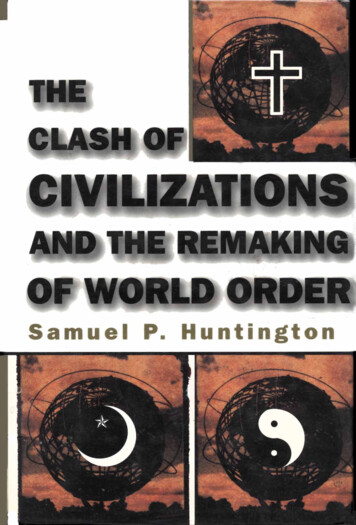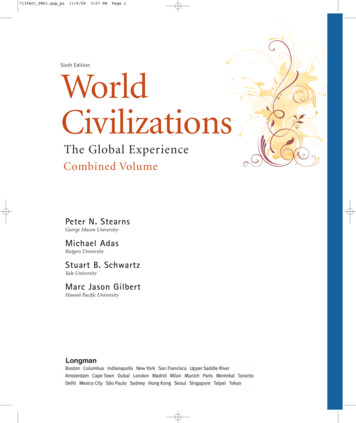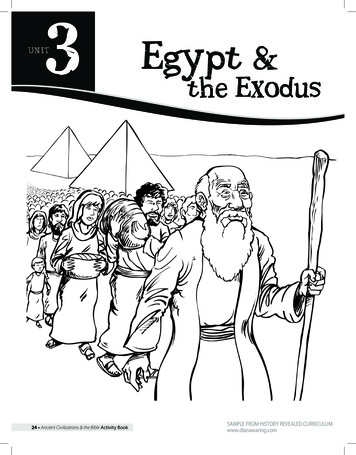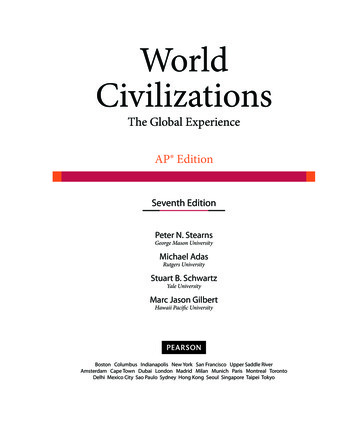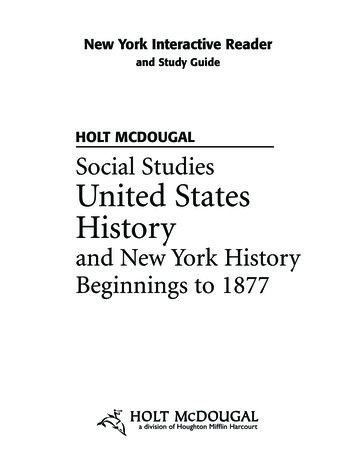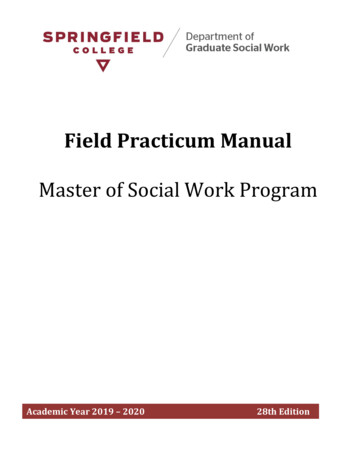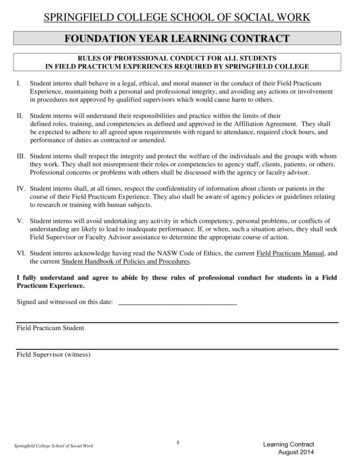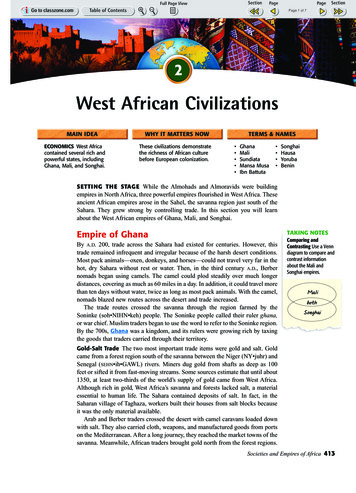
Transcription
Page 1 of 72West African CivilizationsMAIN IDEAECONOMICS West Africacontained several rich andpowerful states, includingGhana, Mali, and Songhai.WHY IT MATTERS NOWThese civilizations demonstratethe richness of African culturebefore European colonization.TERMS & NAMES GhanaMaliSundiataMansa MusaIbn Battuta SonghaiHausaYorubaBeninSETTING THE STAGE While the Almohads and Almoravids were buildingempires in North Africa, three powerful empires flourished in West Africa. Theseancient African empires arose in the Sahel, the savanna region just south of theSahara. They grew strong by controlling trade. In this section you will learnabout the West African empires of Ghana, Mali, and Songhai.TAKING NOTESEmpire of GhanaBy A.D. 200, trade across the Sahara had existed for centuries. However, thistrade remained infrequent and irregular because of the harsh desert conditions.Most pack animals—oxen, donkeys, and horses—could not travel very far in thehot, dry Sahara without rest or water. Then, in the third century A.D., Berbernomads began using camels. The camel could plod steadily over much longerdistances, covering as much as 60 miles in a day. In addition, it could travel morethan ten days without water, twice as long as most pack animals. With the camel,nomads blazed new routes across the desert and trade increased.The trade routes crossed the savanna through the region farmed by theSoninke (soh NIHN keh) people. The Soninke people called their ruler ghana,or war chief. Muslim traders began to use the word to refer to the Soninke region.By the 700s, Ghana was a kingdom, and its rulers were growing rich by taxingthe goods that traders carried through their territory.Comparing andContrasting Use a Venndiagram to compare andcontrast informationabout the Mali andSonghai empires.MalibothSonghaiGold-Salt Trade The two most important trade items were gold and salt. Goldcame from a forest region south of the savanna between the Niger (NY juhr) andSenegal (SEHN ih GAWL) rivers. Miners dug gold from shafts as deep as 100feet or sifted it from fast-moving streams. Some sources estimate that until about1350, at least two-thirds of the world’s supply of gold came from West Africa.Although rich in gold, West Africa’s savanna and forests lacked salt, a materialessential to human life. The Sahara contained deposits of salt. In fact, in theSaharan village of Taghaza, workers built their houses from salt blocks becauseit was the only material available.Arab and Berber traders crossed the desert with camel caravans loaded downwith salt. They also carried cloth, weapons, and manufactured goods from portson the Mediterranean. After a long journey, they reached the market towns of thesavanna. Meanwhile, African traders brought gold north from the forest regions.Societies and Empires of Africa 413
Page 2 of 7West African Empires, 1000–1500Empire of Mali, A.D. 1400Empire of Ghana, A.D. iterraneanSeaTripoli01,000 Miles0 EquatorBBeninCongo R.2,000 KilometersLakeVictoria001,000 Miles0 Equator2,000 KilometersSonghai, 1500Rain forestSavannaDesertMediterraneanMali, 1400Rain forestSavannaDesertMediterraneanGEOGRAPHY SKILLBUILDER: Interpreting Maps1. Region Compare the regions occupied by the Ghana, Mali, and Songhai empires in termsof size and location.2. Human-Environment Interaction How did the environment both contribute resources toand cause problems for traders?Merchants met in trading cities, where they exchanged goods under the watchful eye of the king’s tax collector. In addition to taxing trade, royal officials madesure that all traders weighed goods fairly and did business according to law. Royalguards also provided protection from bandits.Land of Gold By the year 800, Ghana had become an empire. Because Ghana’sking controlled trade and commanded a large army, he could demand taxes andgifts from the chiefs of surrounding lands. As long as the chiefs made their payments, the king left them in peace to rule their own people.In his royal palace, the king stored gold nuggets and slabs of salt (collected astaxes). Only the king had the right to own gold nuggets, although gold dust freelycirculated in the marketplace. By this means, the king limited the supply of goldand kept its price from falling. Ghana’s African ruler acted as a religious leader,chief judge, and military commander. He headed a large bureaucracy and couldcall up a huge army. In 1067, a Muslim geographer and scholar named al-Bakriwrote a description of Ghana’s royal court:PRIMARY SOURCEThe king adorns himself . . . wearing necklaces and bracelets. . . . The court of appeal isheld in a domed pavilion around which stand ten horses with gold embroideredtrappings. Behind the king stand ten pages holding shields and swords decorated withgold, and on his right are the sons of the subordinate [lower] kings of his country, allwearing splendid garments and with their hair mixed with gold.AL-BAKRI, quoted in Africa in the Days of Exploration414 Chapter 15.0L. ChadAFRICA0 LakeVictoriaeNileDjenné r R KanoZaria Noke R.Ifeen uR.2,000 KilometersCongo R.BilmataVolB0 1,000 Miles 0 EquatorGhana, 1000Rain forestSavannaDesertMediterraneanNianiBenin0 0AFRICARAgades.R.R.BTropic of CancerWalata TimbuktuKoumbiGaoSalehL. ChadeDjenné r R KanoZaria Noke R.Ifeen uBenin0BilmataVoltaVolNianiS A H A R AgNiL. ChadAFRICATaghazaRAgadesgNi.eDjenné r R KanoZaria Noke R.Ifeen uTropic of CancerWalata TimbuktuKoumbiGaoSalehAgadesgNiNianiS A H A R A.BilmaWalata TimbuktuKoumbiGaoSalehTaghazaR.Tropic of CancerEGYPTeNilS A H A R poliSijilmasaCairoEmpire of Songhai, A.D. 1500Congo R.LakeVictoria
Page 3 of 7Islamic Influences While Islam spread throughAnalyzing CausesWhy would thedisruption of tradedestroy Ghana’spower?North Africa by conquest, south of the Sahara,Islam spread through trade. Muslim merchants andteachers settled in the states south of the Sahara andintroduced their faith there.Eventually, Ghana’s rulers converted to Islam. Bythe end of the 11th century, Muslim advisers werehelping the king run his kingdom. While Ghana’sAfrican rulers accepted Islam, many people in theempire clung to their animistic beliefs and practices.Animism is the belief that spirits living in animals,plants, and natural forces play an important role indaily life. Much of the population never converted.Those who did kept many of their former beliefs,which they observed along with Islam. Among theupper class, Islam’s growth encouraged the spreadof literacy. To study the Qur’an, converts to Islamhad to learn Arabic.In 1076 the Muslim Almoravids of North Africacompleted their conquest of Ghana. Although theAlmoravids eventually withdrew from Ghana, thewar had badly disrupted the gold-salt trade. As aresult, Ghana never regained its power.Empire of MaliBy 1235 the kingdom of Mali had emerged. Itsfounders were Mande-speaking people, who livedsouth of Ghana. Mali’s wealth, like Ghana’s, wasbuilt on gold. As Ghana remained weak, peoplewho had been under its control began to act independently. In addition, miners found new golddeposits farther east. This caused the most important trade routes to shift eastward, which made anew group of people—the people of Mali—wealthy. It also enabled them to seize power.Sundiata?–1255Sundiata came from the kingdom of Kangabanear the present-day Mali-Guinea border.According to tradition, he was one of 12 brotherswho were heirs to the throne of Kangaba.When Sumanguru, ruler of a neighboringstate, overran Kangaba in the early 1200s, hewanted to eliminate rivals, so he murdered allof Sundiata’s brothers. He spared Sundiata,who was sickly and seemed unlikely to survive.However, as Sundiata grew up, he gainedstrength and became a popular leader ofmany warriors. In 1235, Sundiata’s armydefeated Sumanguru and his troops.Mansa Musa?–1332?Mansa Musa, the strongest of Sundiata’ssuccessors, was a devout Muslim. On his hajj,Mansa Musa stopped in Cairo, Egypt. Fivehundred slaves, each carrying a staff of gold,arrived first. They were followed by 80 camels,each carrying 300 pounds of gold dust.Hundreds of other camels brought supplies.Thousands of servants and officials completedthe procession.Mansa Musa gave away so much gold inCairo that the value of this precious metaldeclined in Egypt for 12 years.RESEARCH LINKS For more on Sundiata andMansa Musa, go to classzone.comSundiataConquers an Empire Mali’s first great leader, Sundiata(sun JAHT ah), came to power by crushing a cruel, unpopular leader. Then, in thewords of a Mande oral tradition, “the world knew no other master but Sundiata.”Sundiata became Mali’s mansa, or emperor. Through a series of military victories,he took over the kingdom of Ghana and the trading cities of Kumbi and Walata. Aperiod of peace and prosperity followed.Sundiata proved to be as great a leader in peace as he had been in war. He putable administrators in charge of Mali’s finances, defense, and foreign affairs. Fromhis new capital at Niani, he promoted agriculture and reestablished the gold-salttrade. Niani became an important center of commerce and trade. People began tocall Sundiata’s empire Mali, meaning “where the king lives.”Mansa Musa Expands Mali Sundiata died in 1255. Some of Mali’s next rulersbecame Muslims. These African Muslim rulers built mosques, attended publicprayers, and supported the preaching of Muslim holy men. The most famous ofthem was Mansa Musa (MAHN sah moo SAH), who may have been Sundiata’sgrandnephew. Mansa Musa ruled from about 1312 to 1332.Societies and Empires of Africa 415
Page 4 of 7Mansa Musa’s KingdomIn 1324, Mansa Musa left Mali for the hajj toMecca. On the trip, he gave away enormousamounts of gold. Because of this, Europeanslearned of Mali’s wealth. In 1375, a Spanishmapmaker created an illustrated map showingMansa Musa’s kingdom in western Africa.Drawn on the map is Mansa Musa holding agold nugget.At the top of the map is Spain. At the bottomof Spain, the Mediterranean meets the AtlanticOcean at the Strait of Gibraltar. South ofGibraltar is Africa. Filling most of the map isNorth Africa, with the Mediterranean extendingeast and the Atlantic west of Gibraltar.DOCUMENT-BASED QUESTIONS1. Determining Main Ideas What was a majorsource of wealth for the Empire of Mali?2. Making Inferences How might Mali’s (andAfrica’s) wealth have influenced interactionsbetween Africans and Europeans?Between the reigns of Sundiata and Mansa Musa, Mali experienced turmoil.There had been seven different rulers in approximately 50 years. Like Sundiata,Mansa Musa was a skilled military leader who exercised royal control over the goldsalt trade and put down every rebellion. His 100,000-man army kept order and protected Mali from attack. Under Mansa Musa, the empire expanded to roughly twicethe size of the empire of Ghana. To govern his far-reaching empire, Mansa Musadivided it into provinces and appointed governors, who ruled fairly and efficiently.A devout Muslim, Mansa Musa went on a hajj to Mecca from 1324 to 1325. Whenhe returned, he ordered the building of new mosques at the trading cities of Timbuktu(TIHM buhk TOO) and Gao. Timbuktu became one of the most important cities of theempire. It attracted Muslim judges, doctors, religious leaders, and scholars from farand wide. They attended Timbuktu’s outstanding mosques and universities.Travels of Ibn Battuta In 1352, one of Mansa Musa’s successors prepared toreceive a traveler and historian named Ibn Battuta (IHB uhn ba TOO tah). A nativeof Tangier in North Africa, Ibn Battuta had traveled for 27 years, visiting most ofthe countries in the Islamic world.After leaving the royal palace, Ibn Battuta visited Timbuktu and other cities inMali. He found he could travel without fear of crime. As a devout Muslim, hepraised the people for their study of the Qur’an. However, he also criticized themfor not strictly practicing Islam’s moral code. Even so, Mali’s justice system greatlyimpressed him:PRIMARY SOURCEThey are seldom unjust, and have a greater abhorrence of injustice than any otherpeople. Their sultan shows no mercy to anyone who is guilty of the least act of it. Thereis complete security in their country. Neither traveler nor inhabitant in it has anything tofear from robbers.IBN BATTUTA, quoted in Africa in the Days of Exploration416 Chapter 15
Page 5 of 7Ibn Battuta left Mali in 1353. Within 50 years, the once-powerful empire beganto weaken. Most of Mansa Musa’s successors lacked his ability to govern well. Inaddition, the gold trade that had been the basis of Mali’s wealth shifted eastward asnew goldfields were developed elsewhere.Empire of SonghaiMaking InferencesWhy might thepeople who hadbeen conquered byMali want to breakaway?As Mali declined in the 1400s, people who had been under its control began tobreak away. Among them were the Songhai (SAWNG HY) people to the east.They built up an army and extended their territory to the large bend in the NigerRiver near Gao. They gained control of the all-important trade routes. Gao was thecapital of their empire.Sunni Ali, a Conquering Hero The Songhai had two extraordinary rulers, both ofwhom were Muslims. One was Sunni Ali, who built a vast empire by military conquest. Sunni Ali’s rule began in 1464 and lasted almost 30 years.Sunni Ali built a professional army that had a riverboat fleet of war canoes anda mobile fighting force on horseback. He expanded Songhai into an empirethrough his skill as a military commander and his aggressive leadership. In 1468,Sunni Ali achieved his first major military triumph. He captured the city ofTimbuktu, which had been an important part of Mali’s empire.Five years later, he took Djenné, also a trade city that had a university. To takeDjenné, Sunni Ali surrounded the city with his army for seven years before it fellin 1473. Sunni Ali completed the takeover of Djenné by marrying its queen.Askia Muhammad Governs Well After Sunni Ali’s death in 1492, his son suc-ceeded him as ruler. Almost at once, the son faced a major revolt by Muslims whowere angry that he did not practice their religion faithfully. The leader of the revoltwas a devout Muslim named Askia Muhammad. He drove Sunni Ali’s son frompower and replaced him.During his 37-year rule, Askia Muhammad proved to be an excellent administrator. He set up an efficient tax system and chose able officials. Adding to the centralized government created by Sunni Ali, he appointed officials to serve asministers of the treasury, army, navy, and agriculture. Underhis rule, the well-governed empire thrived.Despite its wealth and learning, the Songhai Empire lackedmodern weapons. The Chinese had invented gunpowder in theninth century. About 1304, Arabs developed the first gun,Islam in West Africawhich shot arrows. In 1591, a Moroccan fighting force of sevSouth of the Sahara, many convertseral thousand men equipped with gunpowder and cannonsto Islam also kept their Africanbeliefs. They found ways to includecrossed the Sahara and invaded Songhai. The Moroccantheir traditional rituals and customstroops quickly defeated the Songhai warriors, who werein their new religion.armed only with swords and spears. The collapse of theThe status of women in WestSonghai Empire ended a 1,000-year period in which powerfulAfrican societies demonstrates howkingdoms and empires ruled the central region of West Africa.local custom altered Muslim practice.Other Peoples of West AfricaWhile empires rose and fell, city-states developed in otherparts of West Africa. As in Ghana, Mali, and Songhai,Muslim traditions influenced some of these city-states.Other city-states held to their traditional African beliefs.Hausa City-States Compete The Hausa (HOW suh) wereIn many 15th-century Muslimsocieties, women seldom left theirhomes. When they did, they veiledtheir faces. Muslim women in WestAfrica, however, did not wear veils.They also mingled freely with men inpublic, which shocked visiting Muslimreligious leaders.a group of people named after the language they spoke. TheSocieties and Empires of Africa 417
Page 6 of 7city-states of the Hausa people first emerged between theyears 1000 and 1200 in the savanna area east of Mali andSonghai in what is today northern Nigeria. Songhai brieflyQueen Amina’s Reignruled the Hausa city-states, but they soon regained theirIn the 1500s, the Hausa city-state ofindependence. In such city-states as Kano, Katsina, andZazzau (later called Zaria) wasZazzau (later Zaria), local rulers built walled cities for theirgoverned by Queen Amina. She wascapitals. From their capitals, Hausa rulers governed theremembered as the “headdressfarming villages outside the city walls.among the turbans.” Her rule wasEach ruler depended on the crops of the farmers and ondistinguished for its militaryconquests.a thriving trade in salt, grain, and cotton cloth made byThe Kano Chronicle, a history ofurban weavers. Because they were located on trade routesthe city-state of Kano, records:that linked other West African states with theAt this time Zaria, under QueenMediterranean, Kano and Katsina became major tradingAmina, conquered all the townsstates. They profited greatly from supplying the needs ofas far as Kawarajara and Nupe.caravans. Kano was noted for its woven and dyed cloth andEvery town paid tribute to her. . . .for its leather goods.Her conquests extended over 34years.Zazzau, the southernmost state, conducted a vigorousQueen Amina’s commitment totrade in enslaved persons. Zazzau’s traders raided an areaher Muslim faith also led her tosouth of the city and sold their captives to traders in otherencourage Muslim scholars, judges,Hausa states. These traders sold them to other North or Westand religious leaders from religiousAfrican societies in exchange for horses, harnesses, andcenters at Kano and Timbuktu toguns. The Hausa kept some slaves to build and repair citycome to Zazzau.walls and grow food for the cities.All the Hausa city-states had similar forms of government. This YorubaRulers held great power over their subjects, but ministers and other officialscrown made ofacted to check this power. For protection, each city-state raised an army ofglass beads andmounted horsemen. Although rulers often schemed and fought to gaingrass clothstands aboutcontrol over their neighbors, none succeeded for long. The constant20 inchesfighting among city-states prevented any one of them from building ahigh.Hausa empire.Yoruba Kings and Artists Like the Hausa, the Yoruba (YAWR uh buh)people all spoke a common language. Originally the Yoruba-speakingpeople belonged to a number of small city-states in the forests on thesouthern edge of the savanna in what is today Benin and southwesternNigeria. In these communities most people farmed. Over time, someof these smaller communities joined together under strong leaders.This led to the formation of several Yoruba kingdoms.Considered divine, Yoruba kings served as the most importantreligious and political leaders in their kingdoms. All Yoruba chiefstraced their descent from the first ruler of Ife (EE fay). Accordingto legend, the creator sent this first ruler down to earth at Ife, wherehe founded the first Yoruba state. His many sons became the headsof other Yoruba kingdoms. All Yoruba chiefs regarded the king ofIfe as their highest spiritual authority. A secret society of religiousand political leaders limited the king’s rule by reviewing the decisions he made.Ife and Oyo were the two largest Yoruba kingdoms. Ife, developed by 1100, was the most powerful Yoruba kingdom until thelate 1600s, when Oyo became more prosperous. As large urbancenters, both Ife and Oyo had high walls surrounding them.Most rural farms in the surrounding areas produced surplus418 Chapter 15Analyzing CausesWhat was themain reason thatthe Hausa did notdevelop an empire?
Page 7 of 7food, which was sent to the cities. This enabled city dwellers to become bothtraders and craftspeople.The Ife were gifted artists who carved in wood and ivory. They producedterra cotta sculptures and cast in metal. Some scholars believe that the rulerssupported artists. Many clay and metal casts portray Ife rulers in an idealistic way.Vocabularyterra cotta: areddish-brown clay,hard ceramicKingdom of Benin To the south and west of Ife, near the delta of theNiger River, lay the kingdom of Benin (buh NIHN). Like the Yoruba peo-ple of Ife and Oyo, the people of Benin made their homes in the forest.The first kings of Benin date from the 1200s. Like the Yoruba kings, theoba, or ruler, of Benin based his right to rule on claims of descent fromthe first king of Ife.In the 1400s, the oba named Ewuare made Benin into a major WestAfrican state. He did so by building a powerful army. He used it to controlan area that by 1500 stretched from the Niger River delta in the east to whatis today Lagos, Nigeria. Ewuare also strengthened Benin City by buildingwalls around it. Inside the city, broad streets were lined by neat rows of houses.The huge palace contained many courtyards and works of art. Artists working for the oba created magnificent brass heads of the royal family and copperfigurines. Brass plaques on the walls and columns of the royal palace of the obashowed legends, historical scenes, and the deeds of the oba and his nobles.According to tradition, Benin artists learned their craft from an Ife artist broughtto Benin by the oba to teach them.In the 1480s, Portuguese trading ships began to sail into Benin’s port at Gwatto.The Portuguese traded with Benin merchants for pepper, leopard skins, ivory, andenslaved persons. This began several centuries of European interference in Africa,during which they enslaved Africans and seized African territories for colonies.Meanwhile, East Africans—discussed in Section 3—prospered from trade anddeveloped thriving cities and empires.SECTION2This ivorymask is one offour taken fromthe king ofBenin in 1897.It was worn onthe belt of aceremonialcostume. ASSESSMENTTERMS & NAMES 1. For each term or name, write a sentence explaining its significance. Ghana Mali Sundiata Mansa Musa Ibn Battuta Songhai Hausa Yoruba BeninUSING YOUR NOTESMAIN IDEASCRITICAL THINKING & WRITING2. What are some similarities3. How did Ghana’s gold-salt6. DRAWING CONCLUSIONS Which of the two—the Yoruba orbetween the two empires?Explain.trade work?4. How did Sunni Ali build anempire?Mali5. What form of government wastypical of Hausa city-states?bothSonghaithe people of Benin—had more influence on the other?7. COMPARING What are some of the similarities betweenthe Hausa city-states and other city-states you have readabout?8. COMPARING What are some of the similarities betweenSundiata and Mansa Musa?9. WRITING ACTIVITY ECONOMICS What do you think wasthe most effective method Ghana used to regulate itseconomy? Explain your answer in a short paragraph inwhich you touch upon trade routes, gold, and taxes.CONNECT TO TODAY CREATING A POSTERLearn more about the mining and production of salt today. Present your findingsin a poster, with illustrations and captions.Societies and Empires of Africa 419
Merchants met in trading cities, where they exchanged goods under the watch-ful eye of the king's tax collector. In addition to taxing trade, royal officials made sure that all traders weighed goods fairly and did business according to law. Royal guards also provided protection from bandits. Land of GoldBy the year 800, Ghana had become an .
